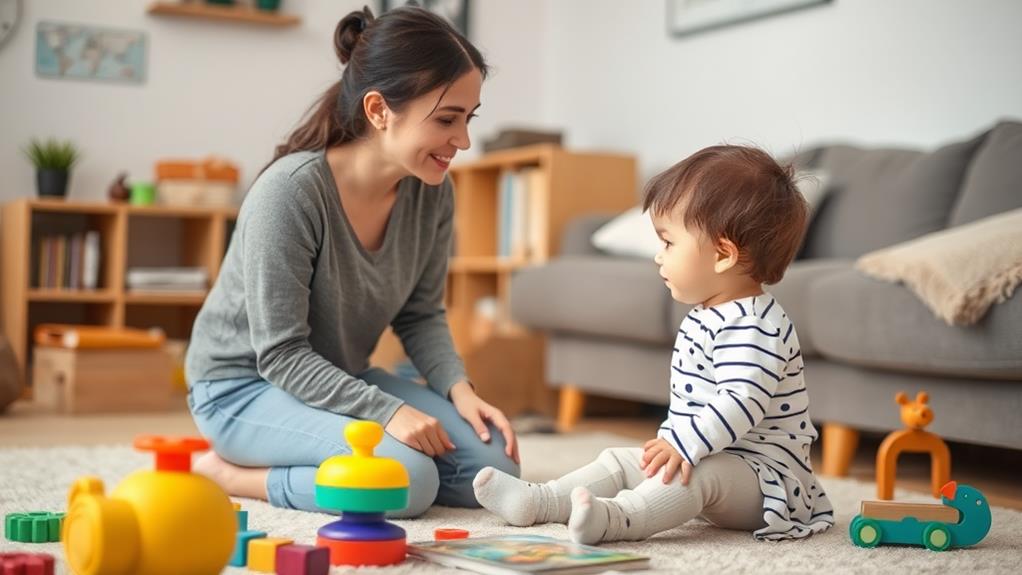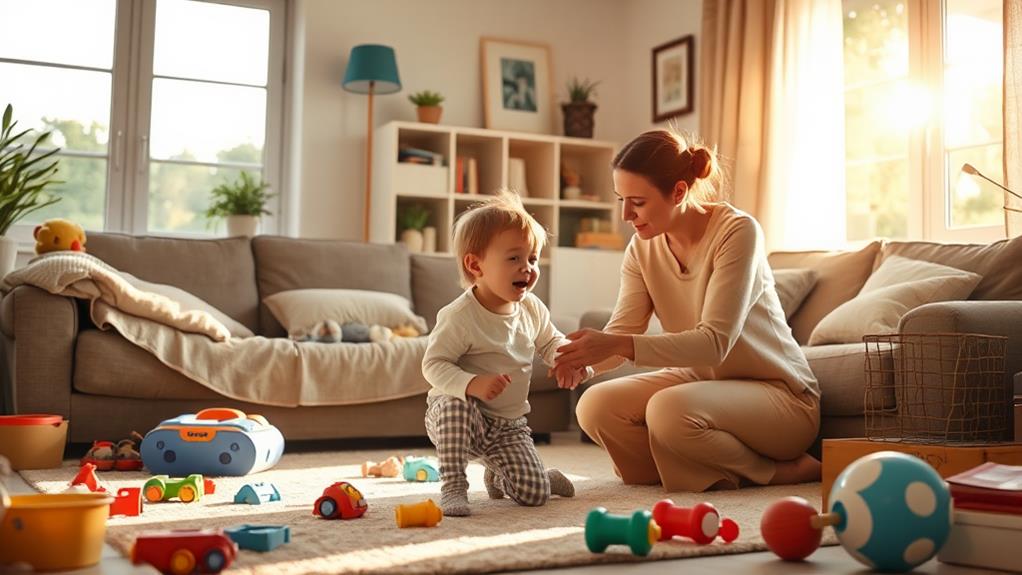How to Get Your Toddler to Listen Without Yelling
Getting your toddler to listen can feel like a daunting task, especially when yelling seems like the only option left. You've probably noticed that traditional methods often lead to frustration for both you and your child. Instead, consider some effective strategies that foster cooperation without raising your voice. By understanding the unique communication challenges you face, you can create a more harmonious environment. But what practical steps can you take to transform these interactions? You might be surprised by how simple adjustments can lead to significant changes.
Understanding Communication Challenges

Understanding communication challenges with your toddler is crucial for fostering a positive interaction. Kids often resist listening because they feel controlled or misunderstood, which can lead to frustrating power struggles.
At this developmental stage, their emotional regulation skills are still maturing, making it tough for them to process complex instructions. When you give too many commands—up to 20 in a short time—your child may become desensitized, making them less responsive to your requests.
Moreover, misbehavior is frequently a sign of unmet needs like attention, hunger, or fatigue. When these needs aren't addressed, your toddler's ability to listen effectively diminishes. It's important to recognize that these communication challenges aren't just about defiance; they're often rooted in their emotional state.
To help your child thrive, practice consistent responses and establish clear boundaries. This approach reduces confusion and increases the odds of compliance.
Key Strategies From Experts
Effective communication with your toddler can significantly improve their listening skills. Start by using simple, one- or two-step instructions. Complicated commands can overwhelm your child, making it harder for them to listen and comply.
Remember to maintain eye contact; getting down to your child's level not only fosters engagement but also enhances their understanding of what you're saying.
After giving instructions, allow a pause of 15 to 18 seconds. This brief moment lets your toddler process what you've said without feeling rushed or pressured. When they do listen and follow through, use positive reinforcement. A simple, "Great job!" can boost their self-esteem and encourage them to repeat the desired behavior.
Consistency is vital, so apply these strategies regularly. Calm and direct instructions can lead to improved listening skills and cooperation over time.
As you practice these techniques, you'll likely notice a positive shift in your child's emotions and actions. With patience and persistence, you're building a foundation for effective communication that can last a lifetime.
Effective Listening Techniques

Listening techniques can make a world of difference when it comes to communicating with your toddler. First, get down to your child's height and maintain eye contact. This eye-level communication enhances engagement and helps them better understand your instructions.
When giving directions, limit yourself to one or two simple commands at a time. Complicated instructions can overwhelm your toddler, leading to confusion and non-compliance.
Use positive phrasing in your communication, such as saying, "Please walk," instead of, "Don't run." This approach encourages a more cooperative response from your little one.
After giving instructions, pause for about 15 to 18 seconds. This brief wait allows your toddler time to process your request and respond appropriately.
Building Connection With Your Toddler
Creating a strong bond with your toddler lays the foundation for better communication and cooperation. When you build a strong emotional connection, your child is more likely to listen right and respond positively. Engaging in regular one-on-one activities fosters a sense of control and security, making them feel valued and understood.
Make eye contact during conversations; this simple act helps your toddler feel connected and seen. Techniques like "Say What You See" (SWYS) are effective in validating your child's feelings before giving requests, which can make them more receptive to following directions.
Establishing a calm and supportive environment is crucial, as children are more likely to listen when they feel emotionally safe. Focus on positive interactions; acknowledging your toddler's strengths boosts their self-esteem and encourages better listening behaviors over time.
When you create these enriching moments together, you not only strengthen your relationship but also enhance their willingness to cooperate. So, invest time in nurturing this bond—your toddler will appreciate it, and you'll likely notice improvements in their listening habits!
Encouraging Positive Behavior

While toddlers often test boundaries, encouraging positive behavior can transform these challenges into opportunities for growth. One effective way to do this is through positive reinforcement. When you recognize and celebrate small successes, you boost your child's self-esteem and motivation.
It's also essential to provide choices. Allowing your toddler to make decisions empowers them and fosters a sense of control, making them more likely to cooperate during routine tasks.
Setting clear limits and expectations creates a structured environment where your child knows what's required of them. Utilize calm communication techniques, summarizing your child's feelings and explaining the reasoning behind your requests. This enhances their willingness to listen and engage.
Remember to communicate at eye level, which not only helps you connect better but also shows respect for your child's perspective. By consistently employing these strategies, you can create a supportive atmosphere that promotes positive behavior.
Using positive phrasing and maintaining a calm demeanor will lead to lasting improvements in your child's behavior and responsiveness. With patience and practice, you'll notice that encouraging positive behavior isn't just effective; it's rewarding for both you and your toddler.
Recognizing Toddler Development Needs
Understanding your toddler's developmental needs is key to fostering a cooperative relationship. Recognizing their basic needs for attention, food, and rest helps you create an environment where cooperation thrives. When you address these emotional and physical needs, you're likely to see improved behavior and fewer instances of defiance.
Remember, toddlers often struggle to express themselves fully, which can lead to frustration for both you and them. By providing support and patience, you enhance communication and listening skills. You're not just reacting to behavior; you're actively engaging with their feelings and experiences.
It's important to acknowledge that toddlers are still developing emotional regulation skills. This awareness allows you to manage challenging behaviors more effectively. When you create a supportive environment that validates their emotions, you help them grow emotionally.
Ultimately, recognizing your toddler's needs isn't just about discipline; it's about building a trusting relationship. As they learn to express themselves and feel secure in your support, you'll find they're more likely to listen and cooperate.
Long-Term Parenting Goals

When you set long-term parenting goals, you're laying the foundation for your child's future happiness and well-being. Focusing on emotional intelligence and effective communication is key. By nurturing these skills, you help your child develop resilience and a growth mindset, which are essential for their self-worth and overall well-being.
Creating a respectful environment at home allows your child to navigate their emotions more effectively. This, in turn, can improve their listening behaviors over time. Remember, avoiding negative labels is crucial; instead, focus on positive reinforcement. This approach can significantly boost your child's self-esteem and encourage them to meet your expectations.
Building a strong parent-child bond is also important. Consistent nurturing strategies and clear boundaries will help foster cooperation and understanding.
As your child grows, these long-term parenting goals will guide them toward becoming a well-mannered individual who thrives socially and emotionally. By prioritizing these aspects, you're not just teaching them to listen; you're equipping them with valuable life skills that will serve them well into adulthood.
Embrace these goals, and you'll pave the way for a brighter future for your child.














Post Comment